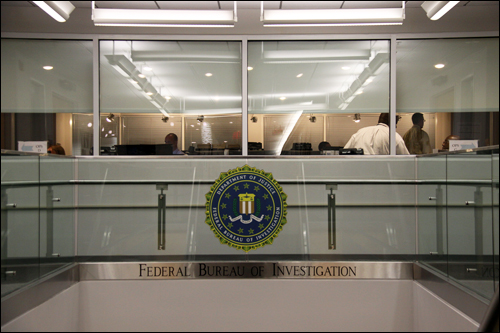SIOC
Strategic Information & Operations Center (SIOC)
SIOC Fact Sheet: History and Facility
The Strategic Information and Operations Center (SIOC) is the FBI’s global command and communications center. It operates around the clock to maintain enterprise-wide situational awareness and to provide FBI leadership with strategic information by serving as a clearinghouse to collect, process, and disseminate information in a timely manner. SIOC leverages existing resources and provides a platform for more informed decision-making. It supports senior leadership and program managers with an expanded information base and the ability to synthesize intelligence and other information. Additionally, the team supports field commanders representing the Bureau worldwide in major investigations, tactical operations, and other matters.
 |
|---|
SIOC maintains a constant state of readiness, ensuring a secure venue to support crisis management, special event monitoring, and other significant operational initiatives. As a Sensitive Compartmented Information Facility (SCIF), SIOC also offers an appropriately secure place for conducting classified briefings, conferences, and seminars.
With 40,000 square feet of space at FBI Headquarters in Washington, D.C., SIOC consists of six crisis action team rooms, five large-scale operations areas, executive briefing areas, and conference rooms. SIOC promotes flexibility, and has the ability to configure its space to:
- Simultaneously support multiple independent operations of varying size, configurations, and requirements for different security levels;
- Accommodate representatives from other agencies, as well as organizations called upon to participate during special events or crisis operations;
- Supply computers, printers, fax machines, shredders, secure telephones, satellite telephones, and high frequency and satellite radios with connections via public and U.S. government communication lines;
- Offer an interactive audio-visual system throughout the facility that includes video teleconferencing systems;
- Provide information management capabilities including electronic libraries of information accessible through a user-friendly FBI-wide Intranet, as well as local-area and wide-area network connections at the unclassified, secret, and top secret security levels; and
- Sustain an uninterrupted power supply and back-up generators.
SIOC’s services go beyond the boundaries of its physical space. Its technological capabilities bring critical information from missions directly to desktops and conference rooms throughout FBI Headquarters and across the Bureau. Such information includes operational updates, the latest news wire services, maps, program information, case files, and intelligence reports.
The Bureau also maintains divisional centers within the Counterterrorism and Cyber Divisions. The SIOC Watch, the FBI’s sole watch center, has responsibility for the daily intake and dissemination of information for all programs, foreign and domestic, as well as administrative issues. It also works closely with Counterterrorism and Cyber divisional units to ensure that the full spectrum of strategic information and emerging events is handled in a seamless and efficient manner. This also ensures the proper flow of information to FBI Headquarters, field divisions, legal attachés, and other government agency operations centers within the intelligence community.
 |
|---|
SIOC was created as a result of multiple simultaneous incidents that demanded a coordinated federal effort to create a national command post that could work around the clock and be ready to gear up at a moment’s notice. The Bureau understood the need for a global watch to centrally manage a major emergency of any kind, as well as oversee several crises at once. Major crimes and terrorist attacks can quickly become national emergencies involving dozens of agencies in different counties, states, and even countries, and the Bureau needed to be able to respond accordingly.
Over the course of its history, SIOC has assisted in resolving a number of national and global crises and major investigations, including:
- The 1995 Oklahoma City bombing;
- The 1996 attack on the U.S. military housing complex in Khobar Towers, Saudi Arabia;
- The 1998 bombings of two U.S. embassies in East Africa;
- The September 11, 2001 attacks on the World Trade Center and the Pentagon;
- The 2002 D.C. sniper investigation;
- The 2005 London bus and subway bombings;
- Hurricane Katrina in 2005;
- The 2009 inauguration of President Barack Obama;
- New York City’s Central Park car bomb attempt in 2010;
- The 2010 Hutaree militia case;
- The 2010 Uganda bombing;
- The 2010 Discovery Center hostage situation near Washington, D.C.;
- The 2011 Tucson, Arizona, shooting incident involving Congresswoman Gabrielle Giffords;
- The 2012 Sandy Hook Elementary School shooting incident;
- The 2013 Boston Marathon bombing;
- The 2013 Navy Yard shooting incident;
- The 2014 Fort Hood, Texas, shooting incident;
- The 2014/2015 St. Louis riots;
- The 2015 Charleston, South Carolina, church shooting;
- The 2015 San Bernardino, California, shooting incident;
- The annual Presidential State of the Union Address;
- The Winter and Summer Olympic Games; and
- The World Cup, Super Bowl, World Series, NBA Finals, and Stanley Cup Playoffs.
SIOC has recently implemented a number of critical applications that provide greater support to both its domestic and international responsibilities. These include:
- The Foreign Tracking Program, which supports the FBI’s commitment to protect the well-being of its employees, their dependents, and contractors when their positions overseas place them at risk.
- The Critical Incident and Operations Unit, which coordinates and prepares the operational activation system at FBI Headquarters for a watch, threat or incident, special event, or natural disaster. This includes coordination with field offices, legal attachés, and specialized national assets when the Bureau is required to manage a critical incident.
- The Operation Center Coordination Office, which provides a platform for Field Office Operations Centers to communicate best practices and innovative ideas for evaluation and potential use enterprise-wide.
- Providing a Common Operation Picture (COP) of all deployed FBI national assets.
09.02.10
| CIRG Links |
|
Counter-IED Operations Investigative & Operations Support Strategic Information & Operations Center (SIOC) Tactical Operations |

